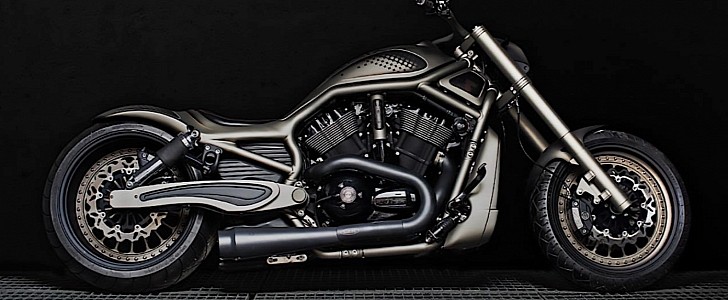The Star Trek universe is a very diverse one, more diverse in the opinion of some (myself included) than that of the franchise it most often gets mistaken for, Star Wars. And in that vast universe there is a species called Trill.
First unveiled in The Host episode of Star Trek: The Next Generation, Trills are an important part in the Star Trek: Deep Space Nine spinoff. Two things stand out the most about these guys: they play host in a symbiotic way for sentient vermiform lifeform, and they distinguish themselves from other humanoid species by two rows of dark spots on each side of their bodies.
The above incursion in the Star Trek universe, which let’s face it has nothing to do with what we usually cover here on autoevolution, was prompted by this here, customized Harley-Davidson V-Rod. Well, not by the bike itself, but by the star-like spots that run down both its sides, and quickly remind trekkies of the Trill species – and that's also why we even nicknamed it so.
The motorcycle is a custom work put together by an Italian garage that calls itself MS Artrix. We’re not told that many things about it, but in some cases pictures are worth a thousand words – and there are a bunch of pics for you to check out in the gallery above.
Put together back in 2015, the V-Rod retains the original frame and engine, but MS Artrix had a hand in reshaping everything else, from the mudguards to the fuel tank cover. Propped on multi-spoke custom wheels, the ride makes use of Rebuffini controls, an air suspension system, and a CFR exhaust. The Trill-like visuals are the work of MS Artrix.
The current whereabouts of the Harley-Davidson V-Rod “Trill” are not known, and so is the price of the build at the time of its making.
The above incursion in the Star Trek universe, which let’s face it has nothing to do with what we usually cover here on autoevolution, was prompted by this here, customized Harley-Davidson V-Rod. Well, not by the bike itself, but by the star-like spots that run down both its sides, and quickly remind trekkies of the Trill species – and that's also why we even nicknamed it so.
The motorcycle is a custom work put together by an Italian garage that calls itself MS Artrix. We’re not told that many things about it, but in some cases pictures are worth a thousand words – and there are a bunch of pics for you to check out in the gallery above.
Put together back in 2015, the V-Rod retains the original frame and engine, but MS Artrix had a hand in reshaping everything else, from the mudguards to the fuel tank cover. Propped on multi-spoke custom wheels, the ride makes use of Rebuffini controls, an air suspension system, and a CFR exhaust. The Trill-like visuals are the work of MS Artrix.
The current whereabouts of the Harley-Davidson V-Rod “Trill” are not known, and so is the price of the build at the time of its making.









